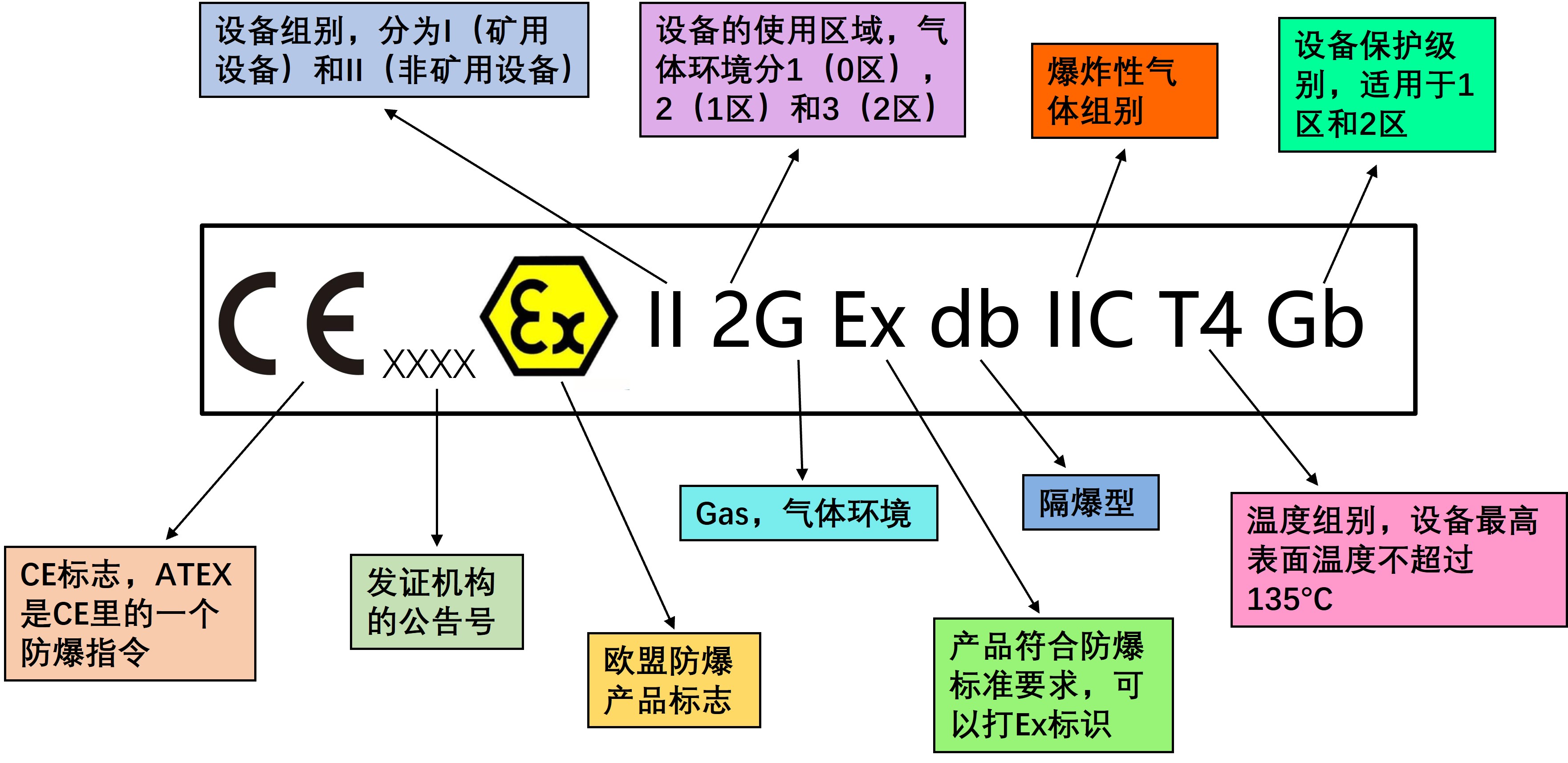
随着我国经济建设高速发展,工业生产规模日益增大,防爆问题显得更为重要。在石油、化工、煤炭、等各行业,功能各异、品种繁多的防爆电器产品被广泛采用。防爆电器在使用中能否稳定安全运行在各类危险爆炸环境中,出厂前必须进行相关严格的防爆测试。深圳中诺检测技术有限公司在防爆领域拥有丰富的产品设计及测试经验,以下是有关新欧盟防爆ATEX认证指令2014/34/EU及相关问题解读。
防爆指令ATEX 2014/34/EU
(旧指令94/9/EC)
ATEX源于法语“ ATmosphereEXlosible ”,1994年3月23日,欧洲委员会采用了“潜在爆炸环境用的设备及保护系统”(94/9/EC)指令。该指令从 1996年开始使用,并且从2003年7月1日强制施行。
这个指令覆盖了矿井及非矿井设备,与以前的指令不同,它包括了机械设备及电气设备,把潜在爆炸危险环境扩展到空气中的粉尘及可燃性气体、可燃性蒸气与薄雾。该指令是通常称之为ATEX 100A的“新方法” 指令,即现行的ATEX防爆指令。
拟用于潜在爆炸危险环境的设备的制造商,应用 ATEX 指令条款并贴附 CE 标志,不用考虑应用其他更多的要求就可以在欧洲任何地方销售其防爆设备。
应用该指令有三个前提条件:
1. 设备一定自身带有点燃源;
2. 预期被用于潜在爆炸性环境(空气混合物);
3. 是正常的大气条件下。
该指令也适用于安全使用必需的部件,以及在适用范围内直接对设备安全使用有利的安全装置。这些装置可以在潜在爆炸性环境外部。
ATEX 2014/34/EU 指令根据安装设备的保护水平将设备划分为三个类别:
1. 1 类( Category 1 ) — 非常高的防护水平
2. 2 类( Category 2 ) — 高防护水平
3. 3 类( Category 3 )— 正常的防护水平
如果设备被用于 0、1或2区,则类目数字后跟一字母G(气体、蒸气/薄雾):
0区 1区 2区
1G类设备 2G 类设备 3G类设备
如果设备被用于 20、21或22区,则类目数字后跟一字母D(粉尘):
20区 21区 22区
1D类设备 2D 类设备 3D类设备
0区:zone 0,爆炸性气体环境连续出现或长时间存在的场所,危险环境存在的时间大于1000小时/年。
1区:zone 1,在正常运行时,可能出现爆炸性气体环境的场所,危险环境存在的时间在10-1000小时/年之间。
2区:zone 2,在正常运行时,不可能出现爆炸性气体环境,如果出现也时偶尔发生并且仅是短时间存在的场所,危险环境存在的时间少于10小时/年
(2) ATEX 1999/92/EC指令
ATEX 1999/92/EC 与 ATEX 2014/34/EU指令并行,是一个涉及改进处于潜在爆炸性危险环境的工人健康和安全保护的低要求 (1999/92/EC) 指令(也称作ATEX 137),规定了改进处于潜在爆炸性危险环境的工人健康和安全保护的低要求。
这意味着基于所涉及的危险的评估,雇主承担大量的职责:
1. 预防工作场所形成爆炸性环境或避免引燃爆炸性环境;
2. 对爆炸性环境和引燃源的可能性进行危险评估;
3. 依据爆炸性环境出现的频度和时间给工作场所分区;
4. 在入口处给区域用符号标识( Ex 符号);
5. 建立并维护一个防爆文档;
6. 根据拟使用的危险区域选择符合 ATEX 2014/34/EU指令要求的设备。
ATEX 1999/92/EC 规定:
0 区场所只能用 1 类设备; 1 区场所只能用 1 类和 2 类设备; 2 区场所只能用 1 、2 和 3 类设备。
这个指令规定了雇主的职责而不是制造商的责任。

新版防爆指令2014/34/EU说明
新版防爆指令2014/34/EU发布于2014年3月29日的欧盟官方公报,2014年4月18日生效的。新版防爆指令2014/34/EU将于2016年4月20日正式执行,旧的指令94/9/EC也随之将被取代。随着指令更新,欧委会将根据新立法架构(NLF)执行防爆指令条例。
新版本的指令在保持产品范围,产品的等级划分,基本安全要求以及一致性评估流程不变的情况下,引入了新立法架构(NLF):更详细地规定了经销营商的义务。同时在新的NFL架构下,对公告机构的在认证过程中的要求更加细化,更加明确机构在认证过程中的职责。
新指令哪些变化
Q:新版防爆指令2014/34/EU的产品范围是否发生变化?
A:整体是没有变化的。与旧指令相比,只是表述方式不一样,内容保持一致。
Q:新版防爆指令何时开始使用?
A:新版本指令于2014年3月29日发布;于2014年4月18日生效;于2016年4月20日执行。
Q:新版防爆指令2014/34/EU的证书何时才能签发?
A:2016年4月20日起才能签发新版指令证书。在这个日期前,公告机构只能做相关方面的准备,不允许签发新版指令的证书。在此日期前,公告机构只能签发旧版本防爆指令94/9/EC的证书。
Q:新版防爆指令2014/34/EU正式执行时,旧版本指令的证书是否有效?
A:仍然保持有效。只要旧版本的防爆指令94/9/EC的证书仍然处于有效期内,那证书将保持有效。
Q:旧版本的防爆指令94/9/EC的证书在2016年4月20日后使用,有什么需要注意的?
A:持有旧版本指令证书的客户,在提供的符合性声明时,需要注意提供新版本防爆指令2014/34/EU的符合性声明。
Q:2016年4月20日以后,根据旧版本指令签发的证书是否能够年审或者更新换证?
A:可以。年审或者更新换证将依据新指令进行操作。
Q:制造商能否在2016年4月20日签署并提供基于新版本指令的符合性声明?
A:不行。新版本指令相关的符合性声明只能从2016年4月20日开始签署